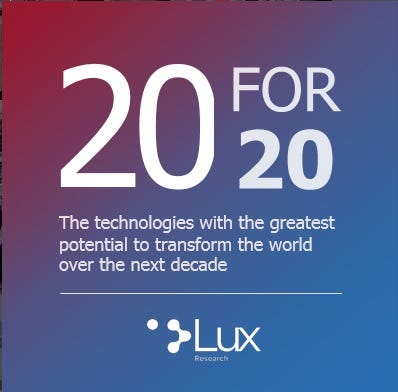Transformational technologies that can change the world
Boston-based Lux Research identifies the top 20 game-changing technologies—what plastics-related tech made the list at #3? Hint: It’s not 3D printing.
November 12, 2019

Lux Research (Boston) released on November 7 its Annual List of Transformational Technologies that are projected to have the greatest impact over the next 10 years.
Lux’s “20 for 2020” report identifies and ranks 20 technologies that will reshape the world, based on innovation interest scores from the Lux Intelligence Engine, along with input from Lux’s leading analysts.
While they are factored in, the report goes beyond megatrends, market demand and new innovations that can thrust many technologies into the spotlight by also providing a shortlist that is intended to provide “data-backed context for the ever-shifting technology landscape and insights into how companies can maximize the investment opportunities these data trends reveal.”
I mean, Lux really goes deep, poring through patents, papers, funding and more.
In short, it lists the emerging technologies that the firm is most bullish on near term and over the next decade. I thought it would be of interest to readers to pull out the ones of particular interest to the plastics community from this fascinating list—and we barely have to go into the list to find the first.
But we’ll begin with what Lux’s identifies as the top two broad transformational market drivers:
1. 5G Networks: From robotic surgery to self-driving cars, 5G will be critical to advances in the internet of things. 5G has officially left the realm of research and entered reality, with more than 2,200 patents being filed this year.
2. Shared Mobility: With more than $10 billion in funding every year for the past three years, shared mobility—like car-sharing services—are reinventing urban transportation. This was a new entry to the leaderboard as is the next.
And at #3, it’s…
That brings us to #3, which is the first in the list to point directly to plastics via a top-of-mind topic that’s of interest throughout the plastics community and beyond because it’s a subset, and perhaps a large one, of a circular value chain.
3. Advanced Plastic Recycling: Innovations that can convert plastic waste into a variety of valuable products, enabling a circular economy and avoiding pollution.
Mission-critical for companies from consumer-packaged goods companies to chemicals, China has invested in recycling technology in a big way, with 55% of all patents coming from that country.
The report expands on the topic in the summary, noting…
Why it’s important: Regulations like single-use plastic bans and waste reduction commitments from brands are shaking up the plastics value chain. Plastic waste recycling is becoming mission-critical for companies from CPGs to chemicals.
What you should do: Companies need to develop waste collection and sorting and help scale up conversion technologies like pyrolysis and chemical recycling. Look for those collecting and converting to present new competition for oil, chemicals, and materials companies in the new circular value chain.

PlasticsToday had already identified this as a high-interest market when noting that reports on this topic, especially recently, appear at the top of our monthly metrics reports of the best-read content.
The Top 25 most-read articles from among approximately 900 published so far in 2019 at PlasticsToday are dominated by the overarching themes of recycling and sustainability, including also these three recent features on advanced recycling:
Dow to source pyrolysis oil feedstock made from recycled plastic waste, published August 2019;
Is plasma gasification the solution for plastics and all waste?, published August 2019;
Is an age-old chemical process the solution to today’s plastic waste problem?, published July 2019.
Some 78 articles appear using the search term chemical recycling, and there are 145 when the term is combined with pyrolysis.
Lux’s Top 5 rounds out with Solid State Batteries followed by Protein Production.
Next: Additional plastic references
Plastic technologies appear at least directly once more, via 3D printing at #8, a 7 position drop from the list for 2019 (the synonymous term additive manufacturing yields more than 1,400 articles at PlasticsToday).
You can also find plastics “hidden” among the remaining technologies where plastics are used or are applicable; for example, that now includes Blockchain, which landed at #15 (see Blockchain technology applied to plastics traceability and sustainability, published October 2019), and 2D materials, which appears at #18. Wikipedia defines two-dimensional materials, which are sometimes referred to as single-layer materials, as "crystalline materials consisting of a single layer of atoms. These materials have found use in applications such as photovoltaics, semiconductors, electrodes and water purification.”
You can find 640 articles on 2D materials at PlasticsToday.
Lastly, I was curious why some technologies that appear smoking hot from this editor’s chair were omitted, for example Robotics/Collaborative Robotics. It seems that growing market and any others fell off the list only because it had either “went mainstream” (which was the case here), changed form (as with wearable technology) or simply fell in relative terms versus hotter tech (for example, AR/VR).
You can find the Lux “20 for 2020” Executive Report PDF for download here.
You May Also Like



